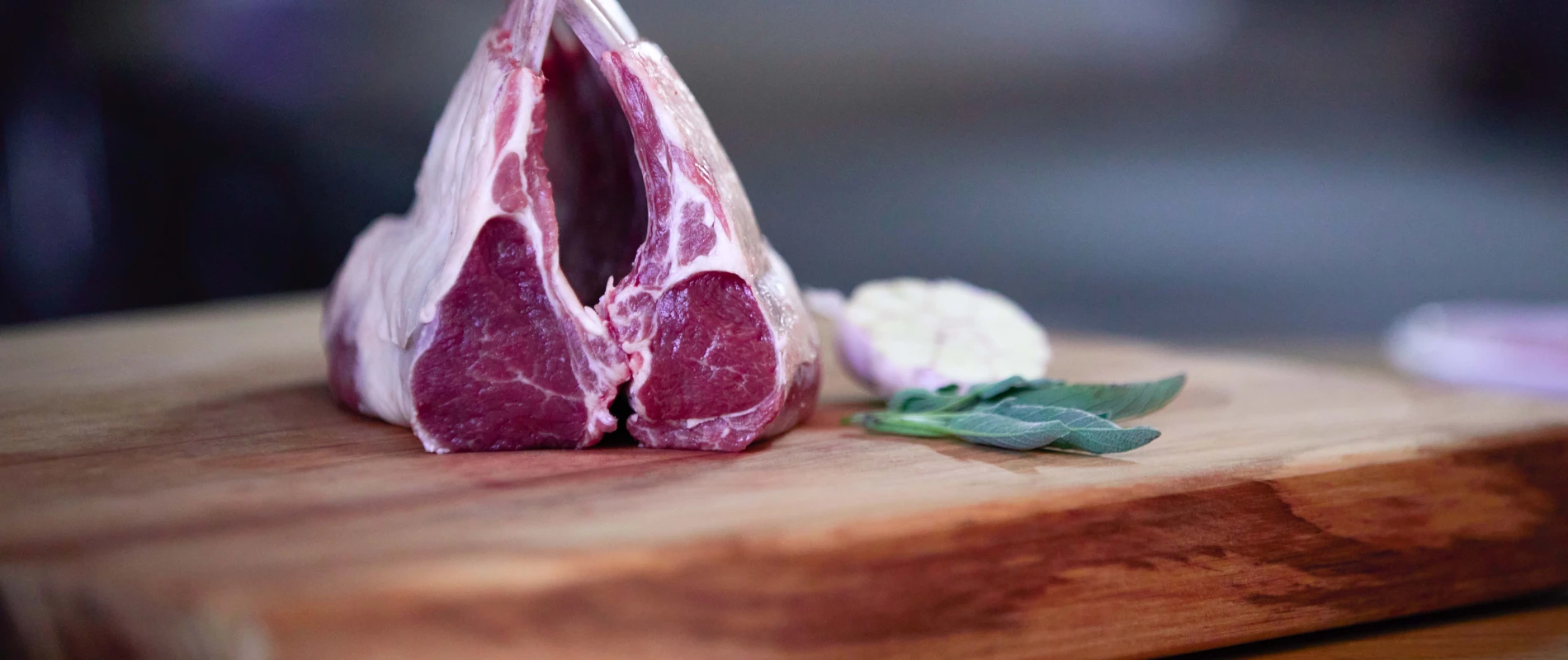
The crowned royal of lamb cuts
A rack of lamb could be said to be the crème de la crème of lamb cuts (but safe to say at Maimoa, all cuts are superior if you know what to do with them). Cut from below the spine and between the shoulder and loin of the lamb, the rack contains rib bones, backbone (chine bone) and a thick meaty rib eye muscle we all love sinking our teeth into. A sought-after cut of meat in today’s dining scene, but the rack hasn’t always been the most prized of cuts.
Yvan who works for Maimoa in Europe recalls, “back in ’89 those lamb racks were a ‘novelty’, but soon you saw them on the menu in every restaurant. Now they have become the most classic lamb item in Europe.”
It was here in the 90’s that we saw a craze in the now retro crown roast, whereby 2-3 racks of lamb were tied into a circle like a crown, revealing the exposed frenched rib bones , chine bones and, when cut into, the golden juicy meat below. Bringing with it the rise in the manchette, a decorative paper covering, used to slip onto meat bones to help with ease of eating at the table. A sophisticated almost white-glove-effect given to the rack of lamb. This, like many other dishes of that time, was theatrical and gave the lamb rack a certain reverence at the dinner table. You could say this was the crowning of the lamb rack as the queen of cuts.
Fast forward to now and the lamb rack is still a prized and popular cut of meat cooked all over the world in all kinds of dining experiences. In fact even manchette’s are finding their way back onto plates of lamb in eateries today. There is no denying the beauty of a rack of lamb lies in its delicate eye muscle of pure non-intramuscular meat. But it is the rib bone holding it together that brings with it extra flavour. The way we prepare and handle a rack of lamb, whereby we cut and scrape the bones down to the eye muscle to show off the beautiful petite rib bones, known as Frenching, and remove the cap of fat, is a testament to its dearness when compared to other cuts of lamb. Regardless of the craze of the crown roast, the combination of bone and tender meat is why the rack of lamb is such a sort after cut. It is a quick cook cut of lamb making it perfect for food service.
A popular way of cooking the rack for service, whether it be a Frenched baby rack or a 8 rib rack, is to initially go hot and fast, fat side down, using a cast iron pan or grill plate, so as to not cook the meat too much. At this point some chefs like to spoon over foaming butter to gloss the meat and enrich the crust. The rack is then turned and finished gently in a moderate oven sometimes doused in hard herbs like thyme and rosemary until cooked to medium rare or between 60-65°C on a meat thermometer . The lamb is then left to rest, sometimes in a nest of fragrant herbs to lock in all the juices and extend its tenderness and flavour. Then it is sliced into cutlets or baby racks dependent on portion size. It is this way of cooking and by going hard fast then finishing gently and resting you get the perfect Maillard reaction in the crust but also tender blush pink juicy meat in the centre.
But it doesn’t stop there. The rack of lamb is quite a versatile cut of meat. A great way to make it more portion friendly is to cut it into mini racks. To do this, place the knife hard-up against the rib bone and cut down through the chine bones. This is also the same for separating the rack into cutlets or chops. These are great briefly grilled or bbq’d over charcoals and served with a tart sauce like salsa Verde. Alternatively, you can crumb and deep fry the cutlets and serve crisp and golden with a dipping sauce or gravy. The eye muscle can also be removed from the bone, poached and served as a medallion or used as the centre piece to a baked pastry for a lamb wellington. The same cut can be frozen as a piece and shaved with a mandolin or sharp knife to be added to hot broths. This is a beautiful way of handling the meat as it sits between raw and cooked, letting the eater really taste the beautiful flavour of the meat and its tenderness. Lots of options that push past the basic rack roast we all know and love.
The rack of lamb handpicked by Maimoa is one of the dearer cuts of meat which is a testament to how it is handled and prepared. Frenched rib bones and a removed cap give this cut a beautiful elegance, but the blush red eye muscle is where the tender cut really shines. This cut of lamb truly is royalty at Maimoa, white manchette gloves and all.